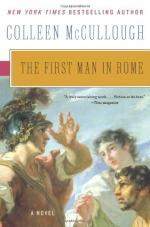|
This section contains 330 words (approx. 1 page at 400 words per page) |

|
In The First Man in Rome, McCullough tells her story against the backdrop of the competitiveness, quarreling, and infighting between the classes of Roman society. This society was stratified into very distinct, well-defined classes. All citizens were either patricians or plebeians. The patrician class represented the original Roman aristocracy, and its members traced their lineage to ancient families. Not all were wealthy, yet they were distinguished by a prestige of birth that no plebeian could ever attain. The plebeian class consisted of all Roman citizens who were not patricians and was further segmented into economic subclasses. While membership in the patrician class guaranteed honor, it did not guarantee a more honorable, intelligent breed of men. Some of the most venal men in the novel are patricians.
The political system of Rome was closely linked to and organized around its class system. In following the maze of...
|
This section contains 330 words (approx. 1 page at 400 words per page) |

|




